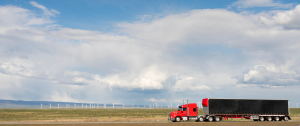
If you ask a trucker about their favorite part of the job, you’re likely to hear something about the freedom to explore this beautiful country.
CDL operators, but especially OTR drivers, can spend hours at a time traveling across the country, taking in spectacular views, exploring new paths, and gaining experiences at the countless truck stops dotting the highways and byways that cover the United States.
For seasoned drivers that have had the chance to explore various routes across the nation, certain paths and truck stops are said to stand out above the rest. Whether due to safety infrastructure, physical beauty, or familiarity and a reminder of home, the following truck stops and routes are known to many truck drivers as their favorites, and for good reason.
Best Truck Stop Chains Nationwide
Many drivers feel that the best part of a truck stop is familiarity. After being on the road for hours, days, and even weeks at a time, recognizing a chain truck stop sign and knowing what features will be included can be a welcome sign.
Pilot Flying J: With over 750 locations across the US and Canada, Pilot Flying J is one of the most well-known truck stop chains and the largest travel center network in North America.
- Amenities: Their stops offer a wide range of amenities, including fuel stations, convenience stores, showers, laundry facilities, and restaurants.
- Perks: Pilot Flying J’s loyalty program provides discounts on fuel, showers, and other services for professional drivers.
- Locations: You will find Pilot Flying J stops along major highways and interstates, making them convenient for long-haul truckers.
Love’s Travel Stops & Country Stores: Founded in 1964, with 644 locations in 42 states, Love’s remains family-owned and operated and is a popular choice for truckers nationwide.
- Amenities: Love’s offers clean restrooms, fast-food restaurants, tire care centers, and truck parking.
- Perks: Their “My Love Rewards” program gives drivers points for every gallon of fuel purchased, which can be redeemed for numerous benefits.
- Locations: Love’s is well-distributed across highways, making it accessible for drivers on different routes.
TA-Petro: Formed as a merger of TravelCenters of America and Petro, this network now features over 270 locations across the nation.
- Amenities: TA-Petro locations provide fuel, dining options including a 24-hour homestyle restaurant, showers, repair services, and convenience stores.
- Perks: Their UltraONE loyalty program offers discounts, points, and rewards for frequent visitors.
- Locations: TA-Petro stops can be found along almost any major interstate and highway.
Sapp Bros Travel Centers: Known for their recognizable coffee-pot-shaped sign and 17 full-service travel centers, Sapp Bros is a can’t-miss spot for truckers looking for friendly service and a reliable experience.
- Amenities: 10 Sapp Bros locations include truck service centers, while 15 provide certified scales, alongside the homestyle Apple Barrel restaurants and Coffee Kettle cafes.
- Perks: The Sapp Bros guest reward card offers drivers a chance to gain points on fuel, shop, and restaurant purchases that can add up to earn benefits such as free showers, free meals, and more.
- Location: Although with fewer locations than some larger chains, Sapp Bros can be found when traveling on Interstate-80 from as far west as Salt Lake City, Utah to Clearfield, Pennsylvania in the east.
Popular Local and Family-Owned Stops
With Trucker Path listing ratings and reviews for over 40,00 truck stops in the US, it can feel difficult to choose one while on the road. However, with these popular locally based stops, you can never go wrong.
Little America (Flagstaff, Arizona): Nestled in the scenic Flagstaff area along Interstate 40, Little America is more than just a truck stop, many say it’s an experience. The sprawling complex includes a hotel, restaurant, and fuel station.
- Amenities: Truckers appreciate the spacious parking lot, clean restrooms, and friendly staff. The on-site restaurant serves hearty, homestyle meals, and the gift shop offers unique souvenirs.
- Location: Find it on the eastbound side of I-40 near Flagstaff.
Kenly 95 Petro (Kenly, North Carolina): Kenly 95 Petro is a family-owned truck stop with a welcoming atmosphere. It’s a favorite among truckers traveling along Interstate 95.
- Amenities: Featuring home-cooked meals at the Iron Skillet restaurant, a well-stocked convenience store, and clean showers.
- Location: Situated off I-95, about halfway between Raleigh and the North Carolina-Virginia border.
Russell’s Truck & Travel Center (Glenrio, New Mexico): Located on historic Route 66 near Interstate 40, Russell’s Truck & Travel Center is known for its nostalgic features and homey charm.
- Amenities: With a free vintage car museum, 24-hour chapel, and an old-fashioned diner featuring classic comfort food like chicken-fried steak and burritos.
- Location: Just inside the New Mexico-Texas border.
Iowa 80 Truckstop: Proudly known as the “World’s Largest Truck Stop,” Iowa 80 is a destination in itself.
- Amenities: It features multiple restaurants, a trucking museum, a barber shop, and even a chiropractor.
- Location: Located in Walcott, Iowa, along Interstate 80.
Popular Routes for Long-Haul Truckers
One of the perks of long-haul or OTR trucking is the ability to travel some of the most scenic routes in the United States. Oftentimes the runs are pre planned according to efficiency and route optimization software, but some truckers choose routes according to past favorites and familiarity.
The following routes are known as some of the most popular, beautiful, and iconic roads in the nation by fellow truckers.
Southwest
- Route 66: Known as the “Main Street of America,” Route 66 stretches from Chicago, Illinois, to Santa Monica, California. While not the fastest route, it’s a nostalgic journey with plenty of truck stops and photo-worthy moments.
- US-93: US-93 connects Wickenburg, Arizona, to the Canadian border in Montana. In the Southwest, it runs through Arizona and Nevada. Expect stunning desert vistas, Hoover Dam, and the infamous lights of Las Vegas.
“New Mexico and Arizona are great,” said CDL driver Christy. “The scenery is beautiful️. Highway 15 through Nevada and Arizona too. Really anywhere in the southwest.”
Out West
- Interstate 90: I-90 stretches from Seattle, Washington, to Boston, Massachusetts. In the west, it passes through Montana, offering breathtaking views of the Rocky Mountains and Big Sky Country. It’s a vital east-west route for both passenger vehicles and trucks.
- US Route 101: US-101 hugs the Pacific Coast, running from Los Angeles, California, to Olympia, Washington. Along the California coast, it offers ocean views, redwood forests, and access to cities like San Francisco and Seattle.
“Highway 200 across Montana is absolutely beautiful,” CDL driver Matthew said. “Especially between Great Falls and Missoula. You go from plains and plateaus to mountains within minutes.”
East Coast
- Interstate 95: I-95 runs along the East Coast, from Miami, Florida, to Houlton, Maine. It passes through major cities like Miami, Jacksonville, Washington, D.C., Philadelphia, and New York City. Expect diverse landscapes, urban areas, and potentially heavy traffic.
- US Route 1: US-1 runs from Key West, Florida, to Fort Kent, Maine. Along the East Coast, it passes through Miami, Raleigh, and Portland. Expect a mix of urban areas and scenic drives on one of the oldest interstates in the nation.
For more information on making the most of your time on the road, make sure to check out more posts on our blog and follow us on social media!



